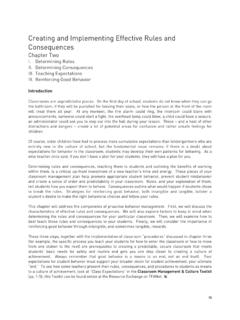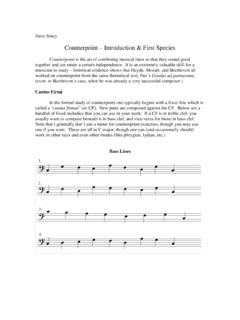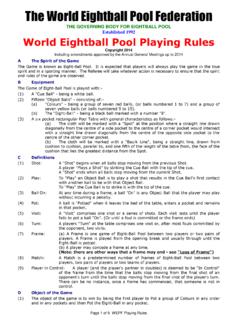Transcription of What the World’s Greatest Managers Do Differently
1 From Soundview Executive Book Summaries February 2000 first , BREAK ALL THERULESWhat the World s Greatest Managers Do DifferentlyBy Marcus Buckingham and Curt CoffmanTHE SUMMARY IN BRIEFB ased on in-depth interviews with more than80,000 Managers at all levels (and in companies of allsizes), the Gallup Organization s Buckingham andCoffman reveal in this summary what greatmanagers do Differently from ordinary Managers tocoax world class performance out of their Managers , write the authors, routinelybreak all the rules .
2 They take the conventionalwisdom about human nature and managing peopleand turn it upside this summary you will learn whichconventional wisdoms to ignore. first , you will finda simple list of twelve questions that will help youassess whether your workplace is the kind of placethat will attract and keep the best will then learn the four keys for unlockingthe potential of each and every one of first key is to select employees based ontalent rather than experience or intelligence.
3 Thissummary will help you learn what talent is and whyyou can t create it from second key is to evaluate performance basedon desired outcomes rather than direct control overthe way a worker performs his or her job. You willlearn how to define outcomes so performance canbe measured and third key to great management is to reject theconventional wisdom that people can be on strength, the authors urge, not onweaknesses. You will learn how to manage fourth and final key is to find the right fit foryour employees talents.
4 Again, you will learn toavoid the conventional wisdom that promotion isthe only just reward for high performance - mindsetthat creates an organization where everyone isultimately promoted to their level of Buckingham is the leader of The Gallup Organization s twenty-year effort to identifythe core characteristics of great Managers and great workplaces. He is also a senior lecturer inGallup s Leadership Institute. Curt Coffman is the global practice leader for the GallupOrganization s Workplace Management Practice. He consults regularly on the development ofproductive customer-oriented summary of first , break all the rules , What the World s Greatest ManagersDo Differently (Simon & Schuster, 1999)
5 Is from Soundview Executive Book Summaries,10 LaCrue Avenue, Concordville, PA , break all the rules from Soundview Executive Book Summaries February 20002 THE THE COMPLETE SUMMARYThe Measuring Stick Today, more than ever, employers realize they mustfind and keep top talent for every role. And theapproach many of them are taking is to offer an arrayof carrots to keep employees happy and around.
6 Theproblem is that carrots in the form of perks areexpensive and may not accomplish their don t distinguish between great performers,mediocre performers or poor ones. Your job, ofcourse, is to attract and keep top , the measures you and your company areusing to determine if you are succeeding may not accu-rately reflect what is really need a new measuring stick. That stick is anassessment of the strength of your workplace. Throughan extensive survey, the Gallup Organization has isolat-ed the 12 characteristics of a strong workplace as thatworkplace is seen through the eyes of the most success-ful and productive employees.
7 If employees can answereach of the following 12 questions affirmatively, youhave a strong workplace, a workplace where the bestwant to work and stay. I know what is expected of me at work? I have the equipment and material I need to domy work right? work, do I have the opportunity to do what I dobest every day? the last seven days, have I received recogni-tion or praise for good work? my supervisor or someone at work seem tocare about me as a person? there someone at work who encourages mydevelopment? work, do my opinions seem to count?
8 The mission/purpose of my company makeme feel my work is important? my co-workers committed to doing qualitywork? 10. Do I have a best friend at work? 11. In the last six months, have I talked to someone about my progress? 12. This last year, have I had opportunities at work to learn and grow? As a manager , it is your job to make sure employeescan respond with a resounding yes to these dozenquestions. If they can, you likely have a strongworkplace capable of attracting and keeping topperformers at every level from the bottom to the top.
9 You probably noticed that there are no questionsabout pay, benefits, senior management ororganizational structure on the list. The reason is thatthose are important to every employee, good, bad ormediocre. Therefore, they aren t a true measure of ahealthy and strong workplace. A workplace withnothing but low-performing employees but an excellentbenefit plan would fare very well on a survey, but thesurvey responses would say nothing about how well thecompany attracts and keeps the best.
10 And therein liesthe folly of the best places to work type surveys. Justbecause a place is a good place to work doesn t mean itwill attract good workers. It may be a popular but weakworkplace. To test this theory, The Gallup Organizationsurveyed 2,500 business units. After assessing theirproductivity, profitability, retention levels and customerratings, employees were asked to answer the 12questions. Consistently, the companies that ranked highest inthe four measures of success had workers whoanswered the questions affirmatively and is, the best business units had more workersrespond that they strongly agreed with each of the 12questions while the worst business units had fewerworkers respond that way.





